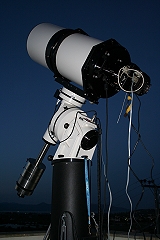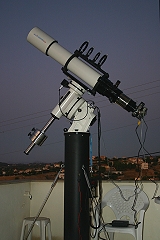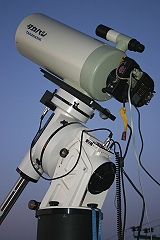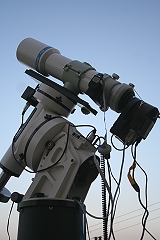
My interest in astronomy is perhaps typical of other amateur astronomers as it dates back to my early youth. Perhaps the germinating seed that
initiated a tremendous fascination for the wonders beyond our planet was NASA's manned space program and, more specifically, the Apollo series
during the late 1960's which, of course, was captivated by the Apollo 11 mission on July 20th, 1969 with the famous
"
The Eagle has landed" (16:17:00 UT-4) and followed a few hours thereafter by
"
one small step" (22:56:15 UT-4).
It was at that time I began to read everything I could get my hands on relating to astronomy, astrophysics, cosmology, SETI and many other
related fields and specialties. Coupled with a very similar and keen interest in science fiction (Star Trek, Isaac Asimov, Ray Bradbury, Robert
Heinlein, Arthur C Clarke and others) and photography, the foundation had been laid for something that would last decades.
Regrettably, commitments to university studies and, following graduation, consulting work necessitated that I somehow keep this incessant and
burning passion in the background. Although I actively kept up with the accomplishments of NASA and actively read Scientific American and
followed such popular television series as Star Trek (all the series) and the X-Files and related specialty programming on the Discovery
Channel, it would be in my late thirties that I would finally find the financial means and, more importantly, time to aggressively start
pursuing a hobby (and flaming passion) whose roots dated back nearly thirty years.
Following countless hours in researching the various telescope designs and their manufacturers, I took a somewhat unorthodox step in purchasing
a research-grade Celestron 14"/f11 Schmidt-Cassegrain telescope with outstanding optics as my first scope. Coupled with an interest in
photography that was initiated in high school and nurtured during the decades that were to follow, my jump into astrophotography was an obvious
and immediate step. In addition to my 14" catadioptric, I was finally notified in early Nov/2004 for an Astro-Physics AP160/f7.5 EDF air-spaced
triplet refractor following a sixty-three-month wait when production finally reached my position in the queue; similarly, in Feb/2006, I was
notified that production reached my position in the queue for the legendary Astro-Physics AP1200GTO GEM; May/2007 when the call arrived for
the Astro-Physics Mach1GTO GEM which is used for remote imaging and/or for simultaneous imaging at home when the AP1200GTO is already employed
for the same purpose; Aug/2010 when I was notified for the Astro-Physics AP305/f3.8 Riccardi-Honders astrograph; and, finally, May/2013 when the
call came for an Astro-Physics AP130/f6.3 Grand Tourismo air-spaced triplet refractor following a nine-yr three-month wait on the notification
list. I am also eagerly awaiting notification for an Astro-Physics Traveller (AP 105 mm/f6), an Astro-Physics AP140/f7 oil-spaced triplet refractor
and, finally, an Astro-Physics AP305/f12.5 Maksutov-Cassegrain. I also own a Takahashi FSQ-106/f5 quadruplet refractor for wide-field deep sky
work and/or total solar eclipse excursions around the world as well as a Mewlon 210/f11.5 (Dall-Kirkham design) which is used for both planetary
and deep-sky work requiring an aggressive image scale.
Photography of the deep sky using extended exposures and quad-colour imaging techniques involve my SBIG ST-2000XM, ST-10XME and STL-11000XM
monochrome CCD cameras yielding image scales ranging from 0.58 to 3.50 arc-sec per pixel using a full suite of LRGB and narrow-band filters with
SBIG CFW8A and CFW10 filter wheels. Canon EOS 300D, 350XT and 5D digital cameras are my primary weapons of choice for widefield lunar and solar
photography (such as eclipses) as well as conjunctions and occultations whereas a DMK 21AU04 USB2.0 camera is used for high-power and
high-resolution lunar, solar and planetary work.
The bulk of my work is performed at my cottage-villa on the northeast outskirts of Athens where my suburban sky reaches a limiting visual magnitude
of 4.0 and which comfortably exceeds 4.5 during mid-winters. For example, Ursa Minor is usually visible in its entirety with/without averted vision;
the Milky Way is a beautiful site year-round and an incessant reminder about the richness of the heavens above; and, many of the brighter DSO's
can be seen with little difficulty. When in pursuit of even darker skies, my favourite location is the absolute top of Mount Kithaironas (1430
m), approximately 90 km northwest of Athens where skies are characterized with a limiting magnitude of at least 6.0 and where I often find
myself above low-level intermittent clouds which may characterize the immediate area at sea-level. During summers, my favourite location is
Mount Parnon, 2.5 hrs southwest of Athens and just east of legendary Sparta, where skies easily reach a magnitude of at least 6.5 and where the
Milky Way overhead is one rich "cloud" covering the sky from the northeast to the southwest and where many Messier objects are visible with the
naked-eye. Two other areas currently under investigation and with immense potential are Mount Helmos (2341 m) in the northern Peloponnese and
Mount Parnassos (2457 m) lying 170 km northwest of Athens and near Ancient Delphi.
The hunger and anxiety to pursue astronomy built-up over nearly three decades is now being satisfied on a full-time basis as I spend countless
hours reading, observing and, most importantly, imaging. I am very determined to exploit the ability of this medium (ie. astrophotography) to
capture the many physical wonders which are out there and, yet, our humble eyes are so helpless in perceiving. A mere look through a telescope,
any telescope, is sufficient to leave one addicted for life to the magic and aura of the countless and timeless celestial wonders which fill
the sky overhead!
To this end, it is my determined intention and hope that this site will become a very thorough and complete digital "library" documenting my
efforts to image the celestial wonders of our magnificent universe using the latest film emulsion, webcam, digital and CCD tools and techniques.
Anthony Ayiomamitis
Athens, Greece
May 18, 2013
 AP 305/f3.8 Riccardi-Honders AG |
 AP 160/f7.5 StarFire EDF |
 Mewlon 210/f11.5 Dall-Kirkham |
 Tak FSQ 106/f5 |
